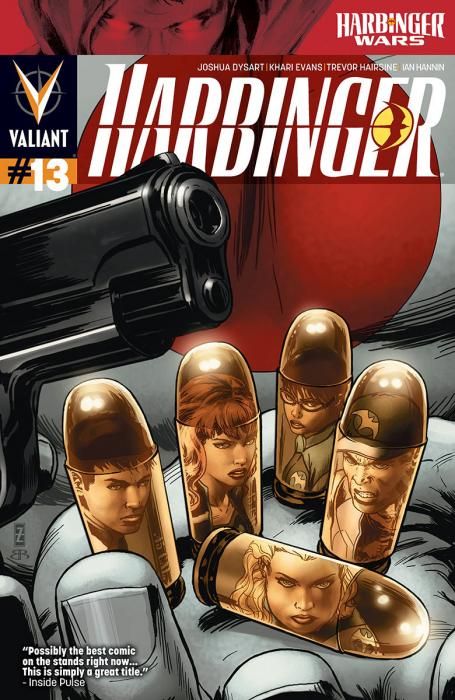"Harbinger" #13 by Joshua Dysart, Khari Evans and Trevor Hairsine continues its own tie-in to the four-part "Harbinger Wars" mini-series, also written by Dysart. In both titles, the cast of superhuman teenagers (or psiots, as they're called in the comics) seek to liberate another group of super-powered youngsters, but now have to face the former psiot-killer Bloodshot in order to do so. But Bloodshot's involvement isn't what the teens think it is.
Dysart does in this latest issue what he's done in every previous issue of this series; he evolves the characters organically, taking enough time to spotlight each character and showcase both their growth and their gelling as a team. Especially convincing is the character of Peter Stanchek (aka Sting), who's transformed from a runaway teen with virtually no control of his powers to a formidable and confident leader who's taking on some pretty powerful foes. John Torkelson (Torque) was a backwater jerk when introduced but plays an important role in this issue. And Faith Herbert (Zephyr) started out and remains the most realistic and likeable pop-culture geek girl character in comics, but is now one who can live out her superhero fantasy by not only flying, but helping others, like any true hero would.
The story, too, has evolved at a natural, comfortable pace, and with its expansion into the plights of other psiots and the backstory of bad-guy supreme Toyo Harada, it yields a situation that's all-too rare in comics: it's a story that needed expanding. So rather than this and recent issues being derailed by tying into "Harbinger Wars," as is often the case when an ongoing title gets touched by an "event" story at other publishers, "Harbinger" has instead actually been enhanced by it. Dysart's been developing this story for over a year, so his ideas have had time to bake and it's readily apparent that they're well-thought out. While there is some redundancy in terms of sequences that take place in both comics, these sequences are in support of a story that is large enough to justifiably span across titles, so it's the repetition is relatively inconsequential. And, Dysart takes some time in this and the past few issues to focus on a young Toyo Harada circa 1969, and his ushering in of the so-called first Harbinger War. These flashback sequences add even more dimension to the story while telling the origin of the title's central villain, much in the same manner that Dysart's been telling the stories of its heroes.
With well-paced panel layouts, artist Khari Evans excels, as usual, at giving the action sequences an almost cinematic quality. Trevor Hairsine and Stefano Gaudiano, who illustrate the Harada flashback sequence, put forth a look that's a little grittier but one that's well-suited to the urban riot scene that serves as the backdrop for the sequence. Kudos should also go to Patrick Zircher for his nicely designed cover, an all-too-simple but clever image of five bullets in the palm of Bloodshot's hand, with the likenesses of Stanchek and the other team members shown in each one.
Driven by great characterization, a consistently solid story, and the gripping premise of a bunch of teenagers having to grow up and face some of the world's most powerful beings, this issue typifies why "Harbinger" could be called one of the best superhero comics currently available.

